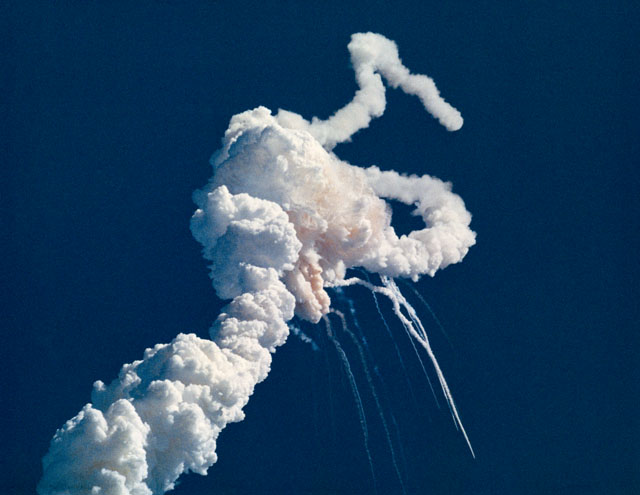
Thirty-one years ago, today, on 28 January 1986, one of the worst and most public disasters in U.S. space history unfolded with horrifying suddenness in the skies above Cape Canaveral. The sight of Challenger exploding, just 73 seconds after liftoff, killing all seven crew members, is so harrowing that for all of us who witnessed it live, it still carries the power to haunt. Over the minutes, hours, days, weeks, months, and years to come, it would be played out again and again via television and later the Internet. The ramifications of the Challenger accident were so profound that they entirely reshaped the subsequent history of the shuttle program. An innocence, astronaut Robert “Hoot” Gibson once said, was lost on 28 January 1986, and never again would words such as “safe” or “routine” or “easy” be employed to describe the fleet of reusable orbiters, the brave souls who flew them, or the work they did. The loss of Challenger served as a stark reminder of the sheer dangers involved in space exploration and the unforgiving nature of high technology.
However, getting Challenger into orbit on Mission 51L that freezing day, all those years ago, proved an exercise in frustration. It was a frustration that NASA could ill-afford. As well as deploying the second Tracking and Data Relay Satellite (TDRS-B) and the Spartan-203 free-flying spacecraft to observe Halley’s Comet, the six-day flight would feature the first private citizen to fly aboard the shuttle: a social studies high school teacher from Concord, N.H., named Christa McAuliffe.
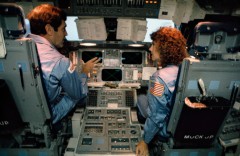
Picked from thousands of applicants for the “Teacher in Space” initiative in July 1985, she was to teach two lessons from space, providing a publicity boost for the space agency as it sought to demonstrate that its reusable fleet of orbiters were operational and to convince senior politicians to support a permanent space station. Years later, McAuliffe’s mother, Grace Corrigan, would insist that the general atmosphere in the weeks leading up to Challenger’s fateful launch was that the shuttle was far safer than an airliner, simply due to the higher number of precautions taken by NASA.
In August 1984, President Ronald Reagan announced the Teacher in Space Project (TISP), requesting NASA to find a gifted educator with the ability to communicate enthusiasm to students from orbit. The not-for-profit Council of Chief State School Officers was selected by NASA to co-ordinate the selection process, and from November 1984 until February 1985 more than 11,000 applications were submitted. These were winnowed down to 114 semi-finalists by state, territorial, and agency review panels, and McAuliffe was one of only two teachers to be nominated in New Hampshire.
In her application she wrote: “I cannot join the space program and restart my life as an astronaut, but this opportunity to connect my abilities as an educator with my interests in history and space is a unique opportunity to fulfil my early fantasies. I watched the space program being born and I would like to participate.”
A judging panel, including former astronauts, university presidents, actress Pam Dawber, former basketball player Wes Unseld, and Robert Jarvik, inventor of the artificial heart, presided over these candidates at interview and eventually narrowed the list to 10 finalists. On 26 June 1985, at the White House, President Reagan remarked to the candidates that “whichever one of you is chosen might also want to take under consideration the opinion of another expert: The acceleration which must result from the use of rockets inevitably would damage the brain, so consider yourself forewarned!” Little could he possibly have known that such dire predictions would come awfully true for the Teacher in Space, early the following year.
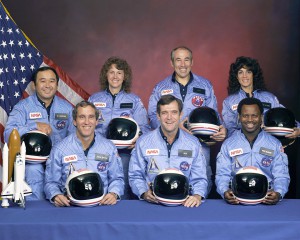
Late in July, it was Vice President George H.W. Bush who announced McAuliffe’s name as the prime candidate, backed up by Idaho elementary school teacher Barbara Morgan. NASA psychiatrist Terry McGuire told New Woman magazine that McAuliffe was the most “balanced” of the finalists, whilst other senior officials found that her endearing manner and infectious enthusiasm set her apart from the others. Training in Houston began in September, and by the time the 51L crew arrived at the Kennedy Space Center (KSC) in January 1986, their launch had already been postponed by delays in bringing Columbia home from Mission 61C and weather concerns at a Transoceanic Abort Landing (TAL) site in Senegal. More trouble was afoot.
Predictions of unacceptable weather in Florida put paid to a second attempt on the 26th and, when Commander Dick Scobee and his six crewmates settled into their seats aboard Challenger on the 27th, they were again thwarted by high winds and a frozen handle on the hatch. In the years that followed, many observers commented that launching on Super Bowl Sunday, the 26th, might well have saved 51L. “It’s another case of fate, playing tricks on you,” remembered former NASA Administrator Jim Beggs in an oral history. “They decided not to launch on Super Bowl Sunday, but Super Bowl Sunday was a fine day. If they’d have launched then, they wouldn’t have had any trouble, so they held it over and caught the cold spell and lost the vehicle and the crew.”
On the night of Monday the 27th, temperatures at the launch site plummeted, precipitously, to an unseasonal -13 degrees Celsius (8.6 degrees Fahrenheit), forcing technicians to switch on safety showers and fire hoses at Pad 39B to prevent water pipes from freezing. This proved particularly worrisome for the ice inspection team, who began their final “sweep-down” of the pad area in the early hours of the 28th and they were obliged to knock a large number of 12-inch (30 cm) icicles away with broom handles as the countdown clock continued ticking toward launch.
Next morning, the Sun rose on the coldest weather conditions under which a shuttle launch had ever been attempted, a fact that would be investigated in depth during the subsequent presidential inquiry into the cause of the tragic events later that day. The copious amounts of ice on Pad 39B forced an additional two-hour delay to permit thawing.
Nonetheless, many of the astronauts’ families, including Scobee’s wife, June, doubted that NASA would fly in such conditions. Her husband insisted, over the phone that morning, that he felt it was safe to do so.
But on this occasion, Scobee was wrong.
The second part of this article will appear tomorrow.
Be sure to “Like” AmericaSpace on Facebook and follow us on Twitter: @AmericaSpace




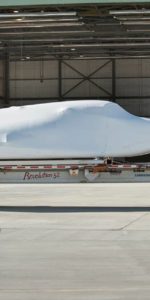
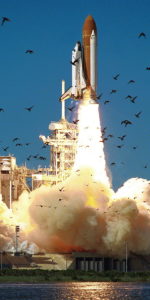
By the, in retrospect, worst luck, I was watching the 51L launch live on CNN. I made a point of watching any I could, and was able excited to be able to see it before I had to go in to work.
I remember the tight shoot on the shuttle, Scobee’s “Roger, go at throttle up”, then the shuttle disappeared and picture was replaced but a live view of the picture at the top of the page.
It was clear to me that the shuttle was lost…